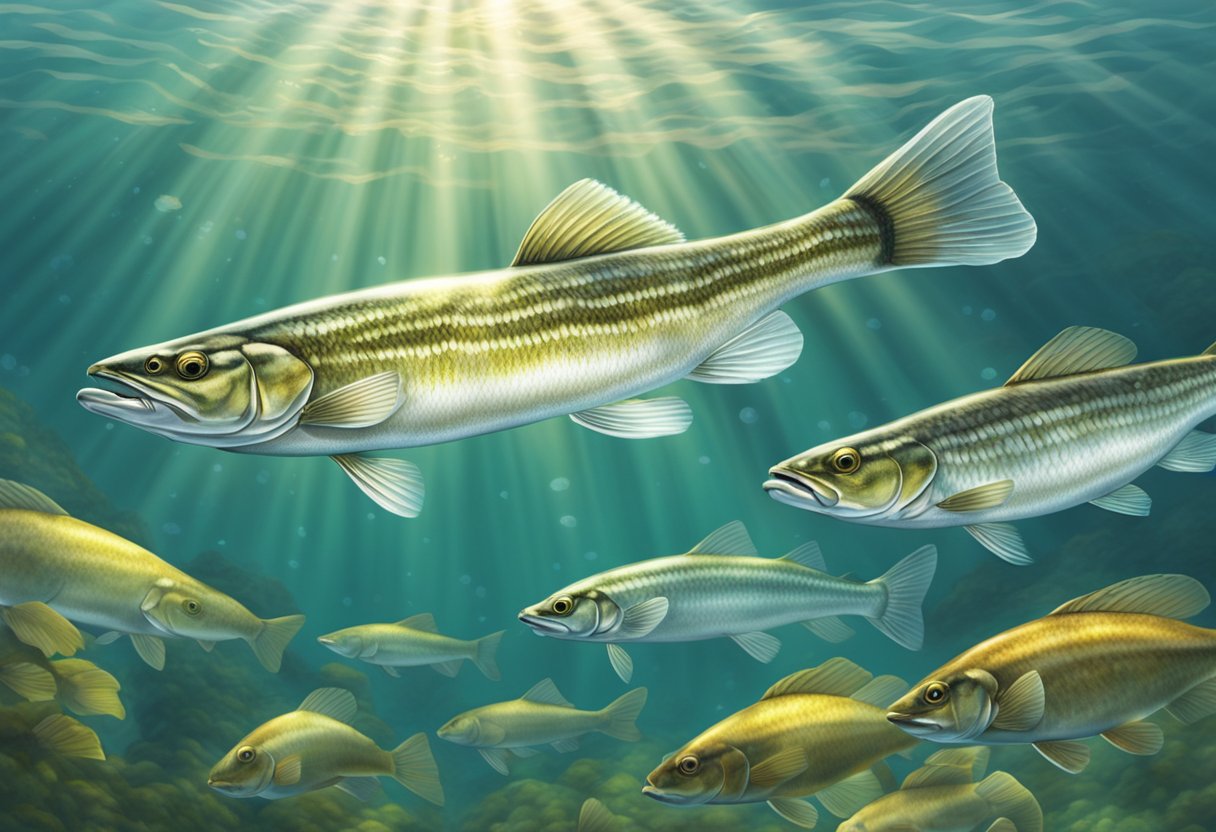Types Of Whitefish
Whitefish is a popular type of fish that is commonly consumed all around the world. It is a great source of protein and other nutrients that are essential for maintaining a healthy diet. Whitefish is a versatile ingredient that can be used in a variety of culinary applications, making it a favorite among chefs and home cooks alike.
There are several types of whitefish that are commonly consumed, including cod, haddock, halibut, sole, and flounder. Each of these types of fish has its own unique flavor profile and texture, making them suitable for different types of dishes. For example, cod is a mild-tasting fish that is often used in fish and chips, while halibut is a firmer fish that is often grilled or baked.
Key Takeaways
- Whitefish is a popular type of fish that is consumed all around the world.
- There are several types of whitefish, each with its own unique flavor profile and texture.
- Whitefish is a versatile ingredient that can be used in a variety of culinary applications.
Types of Whitefish

Whitefish is a term used to describe several species of fish that have white flesh. These fish are found in both freshwater and saltwater. In this section, we will discuss the different types of whitefish and their characteristics.
Flatfish Varieties
Flatfish are a type of whitefish that are found in saltwater. These fish have a flat body and swim on one side. Some of the most common flatfish varieties include halibut, sole, and flounder. These fish are known for their delicate texture and mild flavor. They are often used in dishes such as fish and chips, ceviche, and sushi.
Round Whitefish
Round whitefish are another type of whitefish that are found in both freshwater and saltwater. Some of the most common round whitefish varieties include cod, haddock, and pollock. These fish are known for their firm texture and mild flavor. They are often used in dishes such as fish tacos, fish stew, and fish chowder.
Freshwater Whitefish
Freshwater whitefish are a type of whitefish that are found in freshwater lakes and rivers. Some of the most common freshwater whitefish varieties include lake whitefish, cisco, and mountain whitefish. These fish are known for their delicate texture and mild flavor. They are often used in dishes such as fish cakes, fish pie, and fish curry.
In conclusion, whitefish is a versatile type of fish that can be used in a variety of dishes. Whether you prefer flatfish, round whitefish, or freshwater whitefish, there is a type of whitefish that will suit your taste buds.
Nutritional Profile
Whitefish is a healthy and nutritious type of seafood that is low in fat and high in protein. It is also a great source of vitamins and minerals that are essential for optimal health. In this section, we will explore the nutritional profile of whitefish and its health benefits.
Lean vs Fatty Whitefish
Whitefish can be classified into two categories: lean and fatty. Lean whitefish, such as cod and haddock, are low in fat and calories and are a great source of lean protein. Fatty whitefish, such as salmon and mackerel, are higher in fat and calories but are also a great source of omega-3 fatty acids.
Vitamins and Minerals
Whitefish is a rich source of essential vitamins and minerals that are important for maintaining good health. Here are some of the key vitamins and minerals found in whitefish:
-
Selenium: Whitefish is a great source of selenium, an essential mineral that acts as an antioxidant and helps maintain healthy thyroid function.
-
Potassium: Whitefish is also a good source of potassium, a mineral that helps regulate blood pressure and supports heart health.
-
Vitamin B12: Whitefish is a great source of vitamin B12, a nutrient that is essential for healthy nerve function and the production of red blood cells.
-
Phosphorus: Whitefish is also a good source of phosphorus, a mineral that is important for strong bones and teeth.
-
Niacin: Whitefish is a rich source of niacin, a B-vitamin that helps maintain healthy skin and supports the digestive and nervous systems.
-
Antioxidants: Whitefish contains antioxidants such as vitamin A, vitamin D, and vitamin E, which help protect the body against oxidative stress and reduce the risk of chronic diseases.
-
Calcium: Whitefish is a good source of calcium, a mineral that is essential for strong bones and teeth.
-
Magnesium: Whitefish is also a good source of magnesium, a mineral that plays a crucial role in many bodily processes, including energy production and muscle function.
-
Iron: Whitefish is a good source of iron, a mineral that is important for the production of red blood cells and the transport of oxygen throughout the body.
-
Energy: Whitefish is a low-calorie food that is high in protein, making it a great choice for those who are looking to maintain a healthy weight or build muscle mass.
Overall, whitefish is a nutritious and healthy food that provides a wide range of essential vitamins and minerals. Whether you prefer lean or fatty whitefish, you can be sure that you are getting a healthy and delicious meal that will help keep you feeling great.
Culinary Uses and Recipes
Cooking Techniques for Whitefish
Whitefish is a versatile ingredient that can be cooked using various techniques. Steaming, grilling, roasting, searing, and poaching are some of the popular methods used to prepare whitefish. Each technique brings out different flavors and textures in the fish.
Steaming whitefish is a healthy option as it preserves the natural flavors and nutrients of the fish. Grilling whitefish creates a smoky flavor and crispy exterior, making it a popular option for fish and chips. Roasting whitefish is a great way to achieve a crispy and flaky texture, while searing whitefish creates a golden-brown crust. Poaching whitefish is a gentle cooking method that results in a tender and moist texture.
Popular Whitefish Dishes
Whitefish is a popular ingredient in many cuisines around the world. Here are some popular whitefish dishes:
-
Fish sticks: These are a classic American dish made by coating whitefish fillets in breadcrumbs and frying them until crispy. They are often served with tartar sauce and French fries.
-
Baked whitefish: This is a simple and delicious recipe that involves baking whitefish fillets with herbs, lemon, and butter.
-
Mediterranean baked whitefish: This flavorful dish involves baking whitefish fillets with tomatoes, olives, garlic, and oregano.
-
Almond-crusted whitefish: This is a healthy and tasty recipe that involves coating whitefish fillets in almond flour and baking them until crispy.
-
Fish tacos: These are a popular Mexican dish made by filling tortillas with whitefish fillets, cabbage, salsa, and avocado.
Whitefish can also be used in soups, stews, and chowders. It can be baked, grilled, or fried and served with various sauces and sides. Overall, whitefish is a versatile ingredient that can be used in many different recipes and cuisines.
Conservation and Sustainability
Commercial Fisheries
Whitefish are an important commercial species, and their populations have been threatened by overfishing and habitat degradation. To ensure the long-term sustainability of whitefish populations, many commercial fisheries have adopted sustainable fishing practices. These practices include using selective fishing gear, such as hook and line and traps, which minimize bycatch and reduce the impact on non-target species.
In North America, whitefish are commercially fished in the Great Lakes region, where they are an important source of food for indigenous peoples. In Europe, whitefish are commonly found in the Baltic Sea, where they are harvested commercially by countries such as Russia and Sweden. In Asia, whitefish are also commercially fished in countries such as China and Japan.
Endangered Species and Regulations
Some species of whitefish are considered endangered, and regulations have been put in place to protect them. For example, Atlantic cod, which is closely related to whitefish, has been overfished to the point where it is now considered endangered in some areas. To protect Atlantic cod populations, regulations have been put in place to limit the amount of cod that can be harvested.
In the United States, whitefish are regulated by the National Oceanic and Atmospheric Administration (NOAA) Fisheries. NOAA Fisheries has implemented a number of regulations to protect whitefish populations, including minimum size limits and gear restrictions. In Canada, whitefish are regulated by the Department of Fisheries and Oceans, which has implemented similar regulations to protect whitefish populations.
Overall, sustainable fishing practices and regulations are essential for the long-term conservation and sustainability of whitefish populations. By adopting these practices, commercial fisheries can ensure that whitefish populations remain healthy and abundant for future generations.
Buying and Storing Whitefish
When it comes to buying and storing whitefish, there are a few things to keep in mind to ensure that you end up with quality fish that will taste great and be safe to eat.
Selecting Quality Whitefish
When selecting whitefish, there are a few things to look out for to ensure that you get a quality fish. First, it is important to choose a fish that is fresh. Look for clear eyes, bright red gills, and a shiny, metallic skin. If the fish looks dull or has a strong odor, it may not be fresh.
It is also important to consider the thickness of the fish. Thin fillets are best for frying or broiling, while thicker fillets are better for baking or grilling. Fatty whitefish, such as salmon or trout, are great for smoking, while meaty whitefish, such as halibut or cod, are great for stews and soups.
When it comes to purchasing whitefish, it is important to find a reputable fishmonger. A good fishmonger will be knowledgeable about the fish they sell and be able to answer any questions you may have about the fish.
Preservation Methods
To preserve the freshness of whitefish, it is important to store it properly. Fresh whitefish should be stored in the refrigerator and used within two days. If you are not planning on using the fish right away, it can be frozen for up to six months.
To freeze whitefish, it is important to wrap it tightly in plastic wrap or aluminum foil to prevent freezer burn. It is also important to label the fish with the date it was frozen so that you can keep track of how long it has been in the freezer.
When it comes to substitutions, it is important to note that red snapper can be substituted for whitefish in many recipes. However, it is important to keep in mind that red snapper can contain higher levels of mercury than whitefish, so it should be consumed in moderation.






